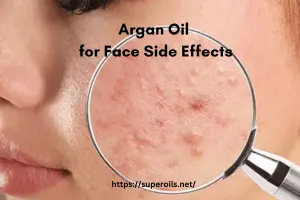Argan Oil for Face Side Effects: What You Need to Know
Published: 26 Feb 2025
Argan oil is widely used in skincare for its moisturizing and anti-aging benefits. However, not everyone’s skin reacts the same way. Some people experience breakouts, irritation, or allergic reactions. Understanding the possible Argan Oil for Face Side Effects can help you use it safely and effectively.
Common Side Effects of Argan Oil on the Face
While argan oil is known for its skincare benefits, it may not suit everyone. Some people experience unwanted reactions, especially if they have sensitive or acne-prone skin. Below are the most common side effects of argan oil on the face:

- Skin Irritation – Some individuals may experience redness, burning, or tingling after applying argan oil. This reaction can occur if the skin is sensitive to certain compounds in the oil. If irritation persists, it’s best to stop using it and switch to a milder alternative.
- Allergic Reactions – Argan oil is derived from tree nuts, so people with nut allergies may develop itching, rashes, or even swelling. A patch test before facial application can help prevent unexpected allergic reactions. If you notice discomfort, discontinue use immediately.
- Acne Breakouts – Although argan oil is lightweight, it can still clog pores for some individuals, leading to pimples and blackheads. Those with oily or acne-prone skin should use it in moderation or opt for non-comedogenic alternatives.
- Excess Oiliness – Applying too much argan oil can leave the skin looking greasy. Since it is highly moisturizing, only a few drops are needed. Overuse can trap dirt and oil on the skin, making it appear shiny and heavy.
- Product Interaction – Argan oil may not work well with strong skincare ingredients like retinol, vitamin C, or exfoliating acids. Combining these can lead to irritation or reduced effectiveness of active ingredients. It’s best to apply argan oil after water-based serums and lightweight moisturizers to ensure proper absorption.
How to Minimize Side Effects?
If you experience irritation or breakouts from argan oil, there are ways to reduce these side effects. Follow these tips to use it safely and effectively:
- Do a Patch Test First – Apply a small amount of argan oil on your inner arm and wait 24 hours. If there’s no reaction, it’s safe to use on your face.
- Use Pure, Organic Argan Oil – Avoid products with added fragrances, preservatives, or chemicals, as they may cause irritation.
- Apply a Small Amount – A few drops are enough. Overuse can make the skin greasy or clog pores, especially for oily or acne-prone skin.
- Check for Allergies – If you have a nut allergy, consult a dermatologist before using argan oil to prevent allergic reactions.
- Monitor Skin Reactions – If you notice redness, itching, or breakouts, stop using the oil and let your skin recover.
- Pair with the Right Products – Avoid using argan oil with strong acids or active ingredients like retinol and vitamin C to prevent irritation.
- Use at the Right Time – Applying it at night helps the skin absorb it better without making it look greasy during the day.
Conclusion
So guys, in this article, we’ve covered ‘Argan Oil for Face Side Effects’ in detail. While argan oil has amazing benefits, it’s important to use it correctly to avoid irritation or breakouts. I personally recommend starting with a patch test and using only a few drops to see how your skin reacts. If it works well for you, it can be a great addition to your skincare routine! Want to learn more about the overall benefits of argan oil for your skin? Check out this detailed guide on Argan Oil for Skin to discover its full potential!
FAQs
Using too much argan oil can leave a greasy feeling on the skin. A few drops are enough to hydrate the face without making it oily. Try applying it at night for better absorption.
Argan oil is a moisturizer, but if your skin feels dry after use, it may not be sealing in moisture properly. Apply it on damp skin to help lock in hydration. If dryness continues, pair it with a hydrating cream.
Stop using it immediately if you experience irritation, redness, or breakouts. Wash your face with a mild cleanser and apply a soothing moisturizer. If symptoms persist, consult a dermatologist.
To minimize side effects, use only a few drops and choose pure, organic argan oil. Always do a patch test before applying it to your face. Avoid mixing it with strong skincare ingredients that may cause irritation.
